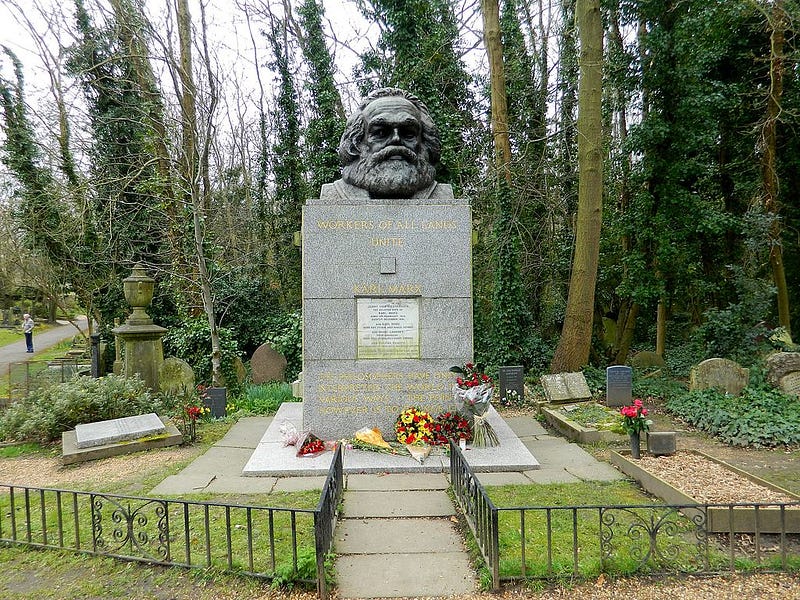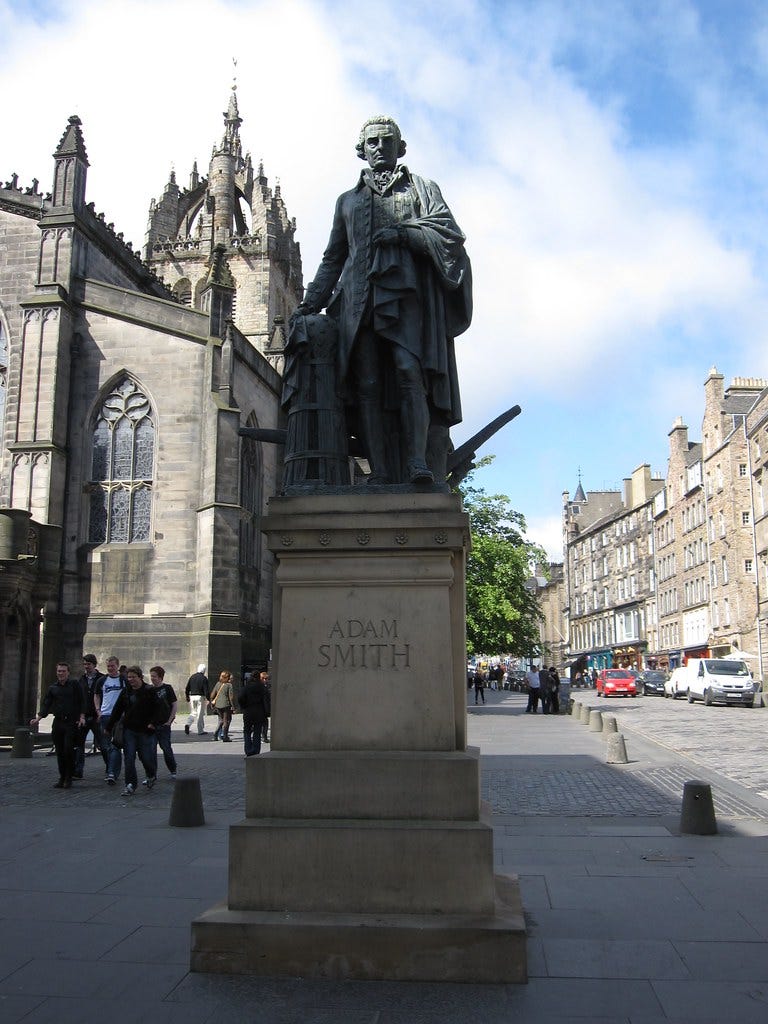Part 2 of a Discussion of Peter Foster’s Why We Bite the Invisible Hand Chapter 2 “The Sage of Kirkcaldy”
In the first part of my discussion of this chapter, we looked at what Peter Foster told us about Adam Smith’s life and the developoment of his ideas that we know today from his two books, The Theory of Moral Sentiments in 1759 and The Wealth of Nations in 1776.
Smith was a virtue ethicist, which roughly means he believed people needed to develop virtues in their life through study and practice if they wanted to find happiness.
This includes the cardinal virtues like prudence, courage, justice, and temperance, but also the Christian virtues of faith, hope and love.
I discuss Adam Smith and virtue ethics in another blog, if you want more information.
While Smith had a well rounded person in mind when he wrote his books, today he is often thought as only caring about prudence. That is not the word we would use today, but prudence means a focus on your self-interest.
As wrong as it is to characterize Smith as only caring for self-interest, it is even worse because most people blend self-interest into selfishness and think of Smith as a caricature of greed and selfishness.
On Foster’s travel to the UK to visit Smith’s grave, he runs right into this mischaracterization of Smith and people’s fears of being associated with such views if they appear favorable to Smith at all.
Foster says he made his first trip to see Smith’s gravesite in 1993 because of a Forbes magazine article, “Tale of Two Tombs,” that highlighted the irony of Smith’s grave versus Karl Marx’s grave.
The article notes that Marx’s grave is well cared for in a privately owned cemetery that charges money — earns a profit — from people wanting to visit. You can see the picture of his well-manicured site above.
In contrast, Smith is in a government-owned cemetery that is free to visit but is rundown from neglect. (p. 37)
Foster observes this reversal in their last resting places is reflected in current attitudes towards each as well.
By any objective measure — or at least so it seemed to me at the time — Adam Smith had been proved stunningly right and Marx spectacularly and murederously wrong. And yet Smith hardly seemed to have as much intellectual — or even popular — support as his nemesis, the man whose theories had caused so much poverty and repression. Indeed, even in his hometown, Smith’s celebration was less than wholehearted. (p. 39)
Foster notes the disparaging quotes about Adam Smith in a little display in the town’s museum.
One was from a collection of profiles of important figures from the Scottish Enlightenment, A Hotbed of Genius: The Scottish Enlightenment, 1730–1790.
Marx regarded Smith as perceptive but heartless, and was more concerned to refute than follow him. (p. 39)
I don’t think most of us would appreciate being described by our critics after we are gone.
The other source of a quote was economist John Kenneth Galbraith who is known for his love of government spending, not the free market where the invisible hand reigns supreme.
At least his quote is funny and a bit true though it still points to Marx.
With Das Kapital and the Bible, the Wealth of Nations enjoys the distinction of being one of the three books to which people may refer at will without feeling they should read it. There is so much in the book that every reader has full opportunity for exercise of his own preference. (p. 39)
As Foster notes, Galbraith is right that many people cite Smith’s beliefs to be in line with their own even when they get Smith’s meaning completely wrong.
In one way, Galbraith’s observation was gallingly correct. Smith continues to be quoted by people with diametrically opposite views, and cited to support causes he might have found problematic, to say the least. In recent years, he has been embraced by leftists such as the linguistic philosopher Noam Chomsky and the Nobel Laureate economist Amartya Sen, and even by climate alarmists. He has been described in the New York Times as “the first action liberal,” when in fact Smith’s liberalism was arguably the very opposite of that promoted by the New York Times. (p. 40)
Foster’s Second Visit
Foster’s was originally inspired to visit the two graves in 1993 after learning about the graveyard situation from a Scottish oilman living in Canada. That man wanted to improve Smith’s gravesite by giving some money to have a sign erected to direct visitors to Smith’s grave. (p. 51) Free money — surely the government council in charge would jump at this opportunity?
Since Foster was returning to Edinburgh in 2002, he offered to follow up on why it seemed nothing was happening with the offer. He arranged a meeting with one of the cultural officials involved who was put in charge of the signage project.
That man’s first answer was blaming bureaucratic inertia, but as the conversation continued, he acknowledged the real issue. The dominant view in Scotland was anti-Margaret Thatcher, and Smith was considered linked to Thatcher ideologically. (p. 53)
It is true that Adam Smith had a resurgence in popularity in the 1980s with government officials serving in both the U.K. Thatcher administration and the U.S. Reagan administration.
Thatcher had reformed many social policies and welfare benefits that angered some in Scotland, and apparently was still angering them nearly two decades later. As such, Smith was tarnished in their eyes, too.
Foster then talks to a sign maker and finds he is not a fan of Smith, or at least not a fan of what the thinks Smith stands for. He thought the world’s problems were the fault of multinational corporations “flaunting their wealth in the Third World” and on income inequality. (p. 54)
The wife of the rector who oversaw the church grounds where the graveyard lay initially seemed interested in accessing the money on offer but ultimately ran into roadblocks that changed her mind. She explained,
There are those who see current attitudes to economics and money-management as being a major contributor to the ever-increasing divide between rich and poor; a division which arguably is contributing to the growth of terrorism, as poor or failed countries try to diminish the power of wealthy ones. This is another reason why I think we do not have much hope of getting simply an Adam Smith sign or set of signs through the Planning Department. (p. 55)
Foster notes the irony in this disdain for Adam Smith as all these people are living in the world of immense wealth compared to all of history prior to 1800 all due to the free enterprise system that Smith was recognizing as the correct path.
Further, Foster thinks Smith would be surprised to see the relatively prosperous Kirkcaldy he lived in had turned into an economically depressed town with high unemployment. Instead of industry, the largest employer was government, many levels of which were primarily focused on income redistribution. (p. 58)
They had turned to a non-Smithian system that left them with lower productivity and thus less prosperity while blaming the free enterprise system for all the ills of the day. Foster sums up,
…how shocked would (Smith) be to learn that the greater part of humanity had, in the 20th century, come under the rule of totalitarian systems that were based on the refutation — indeed the demonization — of his insight?…Smith is an invaluable reference point, even an inspiration, but what is ultimately important is not what Smith thought about how the world works but how the world actually works and how and why we might fail to understand those workings. (p. 60)
Smith was observing the birth of the free enterprise system that brought an immense increase in the standard of living that prior to that time had been stagnant for all of human history.
The gap between rich and poor is not because the free enterprise system makes people poor.
All were poor before. And all would still be poor if free enterprise had not allowed the common man the freedom to put new ideas into action and letting the market set the signals that led to prosperity.
Certainly one company that engenders this prosperity by producing lots of food cheaply while at the same time being reviled is McDonalds, which Foster turns his attention to in the next chapter.
Reference: Foster, Peter, 2014. “The Sage of Kirkcaldy” Chapter 2 of Why We Bite the Invisible Hand, Pleasaunce Press.




